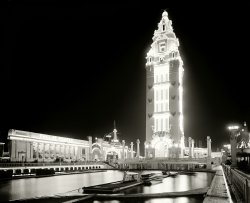
MAY CONTAIN NUTS

Search Shorpy
SHORPY ART

Framed or unframed, desk size to sofa size, printed by us in Arizona and Alabama since 2007. Explore now.
Join and Share
Ad-Free Shorpy
Shorpy is funded by you. Patreon contributors get an ad-free experience.
Learn more.

Recent comments
- Now that's a service station!
- Union Switch & Signal
- Still there -- but not a garage any more
- Must be good breezes there
- Wowzers
- Treescaping
- Still Life With Operator
- +112
- Rear View
- Way in the back --
- Button It Up
- And with an eye on the time ...
- Working in an enclosed ashtray
- Rear View Mirror?
- Tobacco cam
- Basic fact I learned only later in life
- Put a Lid on it!
- Pinstripes in the Tower
- Sound enhancement
- 3438 in '38
- Second Career
- Their days are numbered
- Only the Sensor
- Train control mechanism
- Rarest of the Rare?? & Classy 3400 Class
- Control Mechanism
- Those standpipes
- Wrenches
- International D-40 I believe
- Job prospects
Member Photos
The Shorpy
Printporium
Printporium
Search Shorpy
Search results -- 30 results per page
- Inaugural Ball: 1925
- ... March 4, 1925." And Calvin Coolidge could have danced all night. National Photo Company Collection glass negative. View full size.
... Ballroom Although I'm sure it was in full swing last night, the ballroom looks more staid for meetings these days:
... Posted by Dave - 09/12/2011 - 12:42pm -
![Inaugural Ball: 1925 "Inaugural Ball. March 4, 1925." And Calvin Coolidge could have danced all night. National Photo Company Collection glass negative. View full size.
Balled outBy the time this photo was taken (at the Mayflower Hotel), the only truly new guy -- Vice President Charles W. Dawes -- had already worn out his welcome. As soon as he was sworn into office (in the Senate chambers) he read the senators the riot act about all of their traditions he thought they needed to abandon, while delaying the main event - his boss Calvin's inauguration. From that point forward, Coolidge would have little use for him.
The roomThis is an interesting space: not really huge, almost intimate. The balconies fit right into the overall scale of the room. I just wish it had been a "faster" film so we could see the attendees better.
Re: The RoomThis is an amazing photo -- a surreal phantasmagoria. Like a dream. Or a Fellini movie. If everything was frozen sharp it wouldn't be that way.
[For some reason I keep expecting to see Jack Nicholson staring back at us. - Dave]
The Mayflower Ballroom Although I'm sure it was in full swing last night, the ballroom looks more staid for meetings these days:
Singing in the Rain"I make more money than Calvin Coolidge . . . put together!"
The roomI have been to an event in this room, it is bigger than you think. We had about 55 in our group and the room seemed cavernous. The artwork on the ceiling and walls is beautiful and the balconies are wonderful. The hotel itself is interesting; hallways are almost like a maze amking it hard to find your room. I wonder if some of the attendees got *lost* finding their room after the festivities...
(The Gallery, D.C., Natl Photo, Politics)](https://www.shorpy.com/files/images/13115u_0.thumbnail.jpg)
- Caribou: 1940
- ... a low paid part-time job that usually meant working at night. Alphie probably had plenty of time for shenanigans.
Alphie Michaud ... Posted by Dave - 10/01/2021 - 1:50pm -
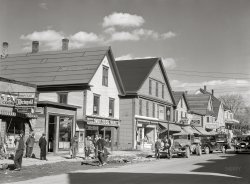
- Luna Park: 1905
- "Luna Park at Night." Coney Island circa 1905. Time exposure on an 8x10 glass negative. ... to get back to Staten Island. We still talk about our night of terror at Coney Island!
Dreamland What a beautiful photo!
... Posted by Dave - 07/20/2012 - 7:13pm -
![Luna Park: 1905 "Luna Park at Night." Coney Island circa 1905. Time exposure on an 8x10 glass negative. Detroit Publishing Company, Library of Congress. View full size.
Hello wall......meet your newest print. Mmm mmm. Fabulous!
Fabulous, indeed.It is just wrong, so wrong, that I never made it to Coney Island in its Glory Days. This picture is spectacular!
My only trip was around 1990, and while still fun (my brother had to retrieve my headband from behind the "Breakdancer" ride, which whipped us in giddy circles -- and which we nicknamed "The Backbreaker" after our third time!), it was definitely a little seedy. As we left, the streetlights and stoplights went out and police officers were trying to direct the honking, yelling HORDES in near pitch blackness.
There were five of us in our little Volkswagen with Texas plates--scared out of our minds and trying to get back to Staten Island. We still talk about our night of terror at Coney Island!
DreamlandWhat a beautiful photo!
It looks like a fantastical place out of a voyage into someone's dreamworld. I wish I could travel back in time...
I was at Coney Island just last week (taking "little ones" to the NY aquarium) and walked past Astroland and promised them a return visit to enjoy the rides. But yesterday's NY papers had headlines announcing the place is closing this Sunday! Another place where dreams and memories are made, lost forever.
Cheek to CheekThis is absolutely gorgeous. Strangely enough, it reminds me of the "Venice" sequence in Fred and Ginger's "Top Hat."
There's a bizarre bit of tarps or something on the left side of the picture, just where the balustrade begins to descend, right above the people. It almost looks like something collapsed there. Any idea what it was?
[They might be the tin hills that formed the backdrop of a spectacle called "The Fall of Port Arthur" -- the reenactment of a naval battle in the Russo-Japanese War. - Dave]
re: Cheek to CheekI hadn't meant that part of the photo (though that's pretty interesting--I've never seen tin hills before!). I was speaking about something below the A and M of "Alhambra", directly over the heads of the people in line.
This site is awesome, by the way! I've been checking in here for about a year, though only just registered for comments this past week.
[More faux rocks, perhaps. - Dave]
(The Gallery, Coney Island, DPC)](https://www.shorpy.com/files/images/4a06542u.thumbnail.jpg)
- Good and Plaid: 1960
- ... given to kids too young to see the point.
A dreaded night of the week in a kid's life.
Wallflowers I wish I could be there ... Posted by Dave - 04/19/2018 - 10:21am -
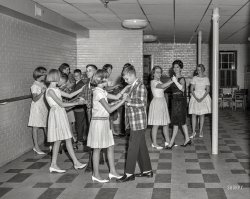
- U-Md: '23
- ... of the hours spent with her daughter combing the hair at night.
Did the unbobbed girls above later give in? Can't tell. Did the ... Posted by Dave - 08/31/2012 - 8:20pm -
![U-Md: '23 "Maryland State, 1923." View full size. National Photo Company Collection.
Maryland CoedsWhooo Boy! Thank science for modern cosmetics and dentistry.
Md. MissesThese girls' faces look so fresh and distinctive. They show an incredible amount of character. I have trouble not looking at the girl with the slight gap in her teeth, and I mean that in the most complimentary sense.
No, they don't look like models or celebrities. And they don't have artificially white, perfect teeth. As I've gotten older I've started to think that all perfection does is make things more sterile and boring. I wish I'd grown up knowing this wonderfully imperfect group.
I agree. They look sweet,I agree. They look sweet, fresh and unique. I guess we have more perfect teeth now--- but we have lost individuality on the way. I would rather have some gapped teeth and a lack of eyeliner as opposed to a carbon copy for everyone.
Md GirlsOh they're beautiful and fresh! Love this photo!
GenuineThey look like real people, and like they would be great fun to hang out with.
And I think their teeth are just fine, too!
Md. Girls Cont'd.They look no more imperfect than (in fact pretty similar to!) the majority of people I DO know today. Modern dentistry and cosmetics are for those who can afford them, which is far from being everyone. And I'd agree that they are more interesting to look at than a flock of modern supermodels, but I doubt that these girls were intended to be that in any case. What's wrong with pictures of ordinary people having fun?
The GirlsWow... I work in PR at a small college, and that could be a promo picture from TODAY except for the fashions. Yeah, I think that as long as you're not exacerbating a structural problem, braces & whatnot are superfluous.
What is remotely unattractive about these girls? They have BEAUTIFUL skin, awesome eyes & good bones. They probably stood up straight, too.
I was thinking...the same thing. These lovely young women are distinctive and appear genuinely happy...and because that happiness shines through their eyes, they are beautiful.
When we speak of a "beautiful" woman today, is she really beautiful...behind her augmented breasts, her furrow-free forehead (via Botox), her liposuctioned stomach and thighs, her Restylane fat lips, her label-conscious clothes, her denture-like gleaming white teeth, etc?
I fear today's women have lost sight of their intrinsic value. We continue to be bombarded (via television, videos, movies, and magazines) with images that lead us to believe we MUST be a "pretty package"...but what's inside that pretty package just doesn't matter. Sigh.
I agreeI agree with most of the comments about these young women, most of whom are betrayed by things like the hair styles of the day. The young lady in the center of the picture to whom your gaze is drawn almost immediately because of the way the others are positioned around her is not stunning but would be eminently attractive in any period - fresh faced and eager to face life for the first time as a real adult.
That said, the girl in the back of the picture with her arm upraised (our left) to my mind bears an unfortunate resemblance to Sean Penn in drag.
Rock the Vote LadiesWomen had been granted the right to vote only five years before this photo was taken...and we're talking about how they look?! How disappointed these pioneering scholars would be with us.
Hair stylesPutting the teeth and faces aside for a moment, it looks to me that we have three girls with short or bobbed hair (the ones where it is blowing in the wind) and two girls with long hair in buns, and one with a goofy hat for which I can't tell. I would suspect that the hatted girl has long hair and I base my guess on the idea that the hat is more old fashion rather than the trendy topper you would expect with a bobbed haired girl.
Girls cutting their hair in the 1920s was a pretty radical thing to do, much more so than a mere style change. For one it was a reversal of centuries of practice and put the girl squarely in the modern camp likely implying rejection of a whole host of social conventions.
I had a older homeroom teacher in junior high in the mid 1960s who told us once about bobbing her hair. She did it in a barber shop since the hair salon ladies of her hometown didn't do it. (That's another whole social deal -- walking into the male preserve of a barber shop). She said that she kept and brought home her shorn tresses and she told us how her mother in tears laid the hair away as a keepsake, recalling all of the hours spent with her daughter combing the hair at night.
Did the unbobbed girls above later give in? Can't tell. Did the short haired girls get hit on more? You can bet on that.
Student BodyIf you have some sort of problem with how these girls look, you should come see our female students now -- fake tans, sweatpants, messy hair, lip gloss, 20 extra pounds, Ugg boots, low tops and drinking problems. I think if I were enrolled 80 years ago, I'd be a lot more proud to say I was a Terrapin.
U-Md buttonsI wonder what the lower part of these U-Md buttons is? kind of bell?
[Those are footballs. - Dave]
(The Gallery, Education, Schools, Natl Photo)](https://www.shorpy.com/files/images/09959u1.thumbnail.jpg)
- Under the Weather: 1922
- ... of the street-cleaning department, said last night that he did not believe it will be necessary to increase his force ... Posted by Dave - 09/04/2012 - 2:45pm -
![Under the Weather: 1922 Washington, D.C. "Blizzard, 1/28/22." National Photo glass neg. View full size.
Knickerbocker BlizzardThis storm became known as the "Knickerbocker Blizzard" because of the collapse of the Knickerbocker movie theater roof from the weight of the accumulated snow. Ninety-eight moviegoers were killed and another 133 injured.
http://en.wikipedia.org/wiki/Knickerbocker_Storm
http://www.weatherbook.com/knickerbocker.htm
With Shovels & WagonsAt a total of 26 inches, papers reported this as the worst snowstorm to strike the city since 1899. (The historically-averaged total annual snowfall in D.C. is about 15 inches.) At the time, the city had no special provisions, equipment, regulations, or budget for removing snow from the streets.
Imperial Tire and Rubber Co. was located at 1235 New York Avenue (corner of 13th St.) I would imagine that their service department was located nearby.
Street-Cleaning Force of 200 at Work Today
With this city almost snowbound the street-cleaning department today will depend upon its regular force of approximately 200 men to keep the principal lanes of travel open.
Thomas Costigan, superintendent of the street-cleaning department, said last night that he did not believe it will be necessary to increase his force because of the storm. He added that he will not put his gang to work until there is a let-up in the snowfall.
"The District has now special appropriation for cleaning away snow," said Mr. Costigan. "Neither have we special snow equipment. We will employ the regular force, beginning, of course, in the downtown district. It may become necessary to put on additional help, but I believe that the regular force will handle the situation satisfactorily."
Mr. Costigan said that the cost of cleaning away the snow will be charged against the regular street-cleaning appropriation, which he estimated is about seven-twelfths expended.
With shovels and wagons, the force split into several gangs, will begin operations at the street intersections where there are car tracks. Narrow streets are given precedence over wide streets by the street cleaners. The snow is transported in wagons to the nearest sewers.
Washington Post, Jan 28, 1922
Citizens Urged to Lend Help
To Clear the Streets of Snow
The District of Columbia is confronted with an emergency.
The municipal government, through its head officials, has admitted that the regular street cleaning force is inadequate in personnel and equipment to meet the situation caused by the storm.
Therefore is it the duty of every citizen to lend a helping hand and perform whatever service he may. Every resident of Washington, whether a home owner or tenant, is appealed to remove the snow from in front of his premises.
The city can not compel a citizen to remove snow from in front of his house. In a situation such as now exists in Washington, a citizen should need no compelling.
It is his moral and civic duty to lend a hand. Do it the first thing today.
Washington Post, Jan 29, 1922
Have a 'Goodyear'!Not exactly a Model T or 26 inches of snow, but after last week's storm:
to all on the site!
Automotive Options in 1922Readers familiar with present-day D.C. government services should take heart: The city's capacity for snow plowing and removal remains on par with experience from 80 years ago. On a different note, the driver of this car surely lamented his failure to roll up his windows -- if in fact this ragtop was equipped roll-up windows.
["Ragtop" is a synonym for convertible -- a body style that didn't really exist until closed cars became the norm in the 1930s. This is an open-bodied roadster. Generally speaking, the only cars back then with roll-up windows were closed-body styles with fixed tops, as opposed to roadsters and touring cars with folding tops. Which might have had snap-on side curtains. - Dave]
Let it snow!Oh, how nice it would be to have a proper snowfall again in the District, just one more time, even if we do view such events as White Death From Sky. Here are a couple of recent messages from Alert DC, a government service which provides "rapid text notification and update information during a major crisis or emergency".
National Weather reports that the District of Columbia is under a Winter Weather Advisory from 10 p.m. until 10 tomorrow morning. National Weather reports that the District could possibly see a tenth-of-inch of rain/sleet mix.
National Weather issued a Winter Weather Advisory in effect from 10 am to 4 p.m. Tuesday. Starting at 10 a.m. Light snow freezing rain and sleet likely mixing with rain in the afternoon. Little or no snow and sleet accumulation. Ice accumulation of less than one tenth of an inch. Highs in the mid 30s.
Stephen in D.C.
Open CarsDoes anyone know how those open cars were weatherproofed inside to withstand moisture?
[Leather seats. Maybe some brass. Not much different from the buggies and runabouts of the horse era. - Dave]
IciclesLooks as though nothing except the street lamp has been warm enough yet to get icicles to form.
It wasn't that terribly coldIt was only in the 20s.* It was the sheer amount of heavy, soggy, moisture-laden snow that made the Knickerbocker storm so dangerous.
In fact, had it been colder there would have been less snow and the snow that fell would have been lighter per given volume. Very cold snow tends to be spikier, which means it doesn't compress as much when it falls. In the same way, kosher salt is lighter (and weaker, if that's the word) per cup than granulated salt.
Snow that forms at warmer temperatures, above about -10C, also contains more moisture per flake, because warmer air can contain more moisture. Heavy, thick snow is most common when the temperature's at or just below freezing.
*Yeah, says the person from Winnipeg.
Snow Removal StrategyIt seems the DC government (and the surrounding jurisdictions in Virginia and Maryland) had the same snow removal strategy then as they do now --
Spring.
(The Gallery, Cars, Trucks, Buses, D.C., Natl Photo)](https://www.shorpy.com/files/images/05682u.thumbnail.jpg)
- Drink Gluek: 1940
- ... neon sign must have served as a beacon in the stormy night to many a thirsty soul. Alas, they are no more. ... Posted by Dave - 01/05/2013 - 12:42pm -
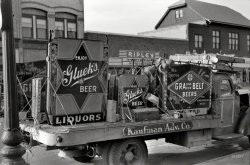
- Commercial Place: 1905
- ... Great pic, as always. Trotter Pharmacy open all night gave me my laugh for the day! Thanks Dave.
Without power steering ... Posted by Dave - 08/13/2012 - 10:23pm -
![Commercial Place: 1905 Norfolk, Virginia, circa 1905. "Commercial Place, Norfolk." 8x10 inch dry plate glass negative, Detroit Publishing Company. View full size.
Old Henry "Old Henry Rye", not to be confused with "Oh Henry," the candy bar, which didn't appear until 1920.
Trotter's Drug StoreJ.M.F. Trotter, who ran his drug store at 124 College Place in Norfolk, was an active member of the Virginia Pharmaceutical Association. In the 1880s he appears to have lived in Danville. After 1898 he appears in Norfolk.
Signs of the timesOne thing which always stands out in these older images is the skill of the old sign painters and sign makers.
To find a really skilled sign painter nowadays, who really knows his stuff is a rare bird indeed.
Real sign painters who understand letters, spacing and fonts have, for the most part, been replaced by computer operators who have little understanding of the sign makers craft.
All gone nowMiller & Rhoads is no more.
All those buildings are no more.
They did complete the monument with a confederate soldier on top in 1907.
Odd symbolWhat's that odd domino-like sign or symbol on the Arco building on the second floor to the left? Almost looks like a face.
[You're close! - Dave]
Open all dayHey, they had 24 hour drug stores in 1905.
My first google street view contribution.Hope I get this right. You guys always beat me to it!
View Larger Map
Bring the kids!There sure are a lot of liquor sellers in the photo, but my favorite is "Family Liquor Store" way at the end of the street.
AdvertisingGreat pic, as always. Trotter Pharmacy open all night gave me my laugh for the day! Thanks Dave.
Without power steeringCan you imagine the skill of the drivers to be able to park those wagons against the curb like that?
(The Gallery, DPC, Horses, Norfolk, Stores & Markets)](https://www.shorpy.com/files/images/4a12472a.thumbnail.jpg)
- Skooter: 1928
- ... Car Pavilion. Visitors can hear live music and dance the night away in this unique, historic building throughout most of the year.
... Posted by Dave - 11/04/2012 - 8:00pm -
![Skooter: 1928 Bumper cars at the Glen Echo amusement park in Montgomery County, Maryland, circa 1928. National Photo Company Collection glass negative. View full size.
The Kid With No HeadThere's a ghostly figure of a man next to the kid on the right with no head. This ride is too dangerous, Mommy!
Been there!I rode those in the early 1960s ..
They used to have a radio jingle:
"Fun is where you find it,
Where do you find it?
Glen Echo
Amusement Park!"
I can still hear it today.
Little Ladiesapparently didn't play on such an aggressive ride back then!
Dashing Here & There Washington Post, May 25, 1924
The "Skooter," the big feature this season, has twenty-five two-seat cars that dash here and there bumping into one another over 10,000 square feet of steel flooring, electrically driven and controlled by the driver.
Bumper Car PavilionThis building still exists. There's an NPS page on its history.
BirdsI bet the mesh on the rafters was to keep birds from roosting up there and doing what they do on the people below.
[The mesh carries the electrical current that powers the cars. - Dave]
Bumper CarsYou know you're getting old when the kids start misidentifying things "everyone" knows. I remember the sound of the metal strip sparking as it glided over the mesh, the tinge of ozone in the air. There were occasionally dead zones in the mesh. The operator would have to push you a few feet, or you would have to wait for a friendly bump. Six Flags still has this type of ride available, as will many older amusement parks. Since the primary enjoyment of this ride is low-speed vehicular collisions, they have been less popular with park owners.
Glen Echo echo"The coaster dip is cool
and so's the crystal pool,
bla bla blablabla bla bla bla bla
Glen Echo Amusement Park."
The song is in my head, too, but what are the "blabla" words?
Glen Echo After DarkI think the bla-bla words are
For summer time fun it's Glen Echo after dark
And no seat belts either!I wonder how many riders fell out of the cars?
Bumper Car Pavilion is a dance hall nowToday, the Glen Echo Park Partnership for Arts and Culture (www.glenechopark.org) presents dances in the Bumper Car Pavilion. Visitors can hear live music and dance the night away in this unique, historic building throughout most of the year.
(The Gallery, Natl Photo, Sports)](https://www.shorpy.com/files/images/31089u_0.thumbnail.jpg)
- Brutalist Garage: 1963
- ... street level retail to the garage. It's most attractive at night, when the neon under lighting on the base makes the structure glow.
... Posted by Dave - 03/21/2018 - 8:42pm -
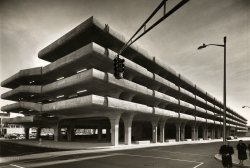
- Thick and Fast: 1938
- ... of political-speak.
Only in the City by the Bay By night, an innocent watchmaker; by day, a brilliant political thinker and ... Posted by Dave - 03/06/2016 - 2:47pm -
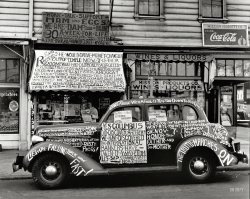
- Ready to Roll: 1943
- ... tough!
Getting on one of those tanks on the move at night in the rain, sleet or blowing snow by the light of a coal oil lamp was a ... coffee table photo book that was comprised of all night photos of steam trains in Virginia (I believe). In the book they noted ... Posted by Dave - 08/05/2012 - 1:12pm -
![Ready to Roll: 1943 March 1943. Barstow, California. "Head brakeman J.C. Shannon (left) and swing brakeman B.E. Wilson waiting for their train to pull out of the Atchison, Topeka and Santa Fe yard." Nitrate negative by Jack Delano. View full size.
The Wheels Were Always Waiting.These guys were tough!
Getting on one of those tanks on the move at night in the rain, sleet or blowing snow by the light of a coal oil lamp was a challenge.
Sort of a grasping leap in harmony with the moving train. Footing impeded with sloped ballast edge or deep snow while carrying the lamp, which would go 'out' if roughly handled.
You had only one chance! on a moving tank.
If your boot heel slipped beyond the stirrup you could feel the wheel rubbing against it just waiting to carve you to bits if your hands slipped and you pivoted under and fell.
Flat cars were worse to board, with less to grab.
The Engineer could never stop in time, if he even saw you slip and fall far back in the train, the tonnage pushing.
No radios, then.
If you had to 'walk' the top of the train to relay hand signals, set up or take down retainers or apply hand brakes, when required by whistle signal, you climbed down to the tanks from the boxcars and went around the outside of the tank on the wooden running board holding on to the hand rail pipe at speed.
The tops of the high cars rocked back and forth sideways in answer to the staggered rail joints under the wheels, and it was often better to run than walk, jumping car-to-car, with a long fall to the waiting wheels below.
Ice and snow made this a challenge, rain too, or if the catwalks were slippy with oil from an oil-fired engine or a new Diesel's exhaust.
Too old to go back, and glad of it.
Thank You.
BarstowMy hometown.
Life imitating art?That could be a still from a movie starring the young Spencer Tracy and Charles something (I keep forgetting the name).
[Bickford? Laughton? Ruggles? Butterworth?]
Charles Laughton, I think. Thanks for the pointers!
A moments respiteAs a former yard brakeman, this brings back the memories of a few quiet moments waiting for someone else to do their work and get out of our way. That tank car was not only a nice place to sit, but it had a two step stirrup with a high running board, making it a much easier car to get on of off than many tanks and flats. The Nickel Plate Road safety officer always discouraged our trying to get on or off this type of car while it was in motion. Maybe that little advice contributed to our being a Harriman Safety Award winner so often.
Since the air hoses between the tank and box car are not connected, there is still some work to do before this cut becomes part of a train. But the guys shown here certainly have the wherewithal to assemble it.
InitialsPerhaps one of you old railroaders could refresh my memory on this. Several years ago my daughter bought me a wonderful coffee table photo book that was comprised of all night photos of steam trains in Virginia (I believe). In the book they noted the tradition of railroaders using initials instead of names. Thoughts?
[Possibly O. Winston Link's Ghost Trains or Steam Steel and Stars]
Yes, I believe that it is indeed Steam, Steel, and Stars!
Brakeman in 1943?KC Ry.,
Your account of a brakeman is accurate, in the days before Westinghouse Air Brakes, pre-1893. In the photo I see brake shoes on the tank car, and an air line between the cars.
Q - What then was the role of a Brakeman in 1943? Setting of brakes when cars were uncoupled?
Jack Delano RR photos are always enjoyable.
GraffitiGee, where is all the "beautiful" spray-can artwork that adorns out present-day rail stock? Although I am an artist, I can't stand this vandalism. Not only a waste of paint, but detrimental to the environment. The photo looks like source material for one of Norman Rockwell's cover projects.
(The Gallery, Jack Delano, Railroads)](https://www.shorpy.com/files/images/8d27524u.thumbnail.jpg)
- Dead Ox Flat: 1939
- ... I'm willing to bet she sat at that piano every Saturday night, turned that hymnal to p. 239 and played "Nearer My God To Thee" thrice, ... Posted by Dave - 09/08/2011 - 5:17pm -
![Dead Ox Flat: 1939 October 1939. "Mrs. Hull, in one-room basement dugout home. Dead Ox Flat, Malheur County, Oregon." View full size. Photograph by Dorothea Lange.
Good MethodistAnd I'm willing to bet she sat at that piano every Saturday night, turned that hymnal to p. 239 and played "Nearer My God To Thee" thrice, singing all three verses as she played.
Love that smile!
Denny Gill
Chugiak, Alaska
"Call for Philip Morr.....is"Handsome looking woman, did she smoke Philip Morris cigarettes? A couple of observations: If she is "Mrs" Hull, where is her wedding ring? And I found the lace pattern on her shoes to be quite interesting ... I don't believe I've ever seen shoes that lace like that.
[Mrs. Hull, a Quaker, had a husband and a daughter. Wedding bands generally are not part of the Quaker wedding ceremony. - Dave]
Re: Call for Philip MorrisThat's not the Philip Morris boy. It's a McCall's magazine cover.
Handsome, indeedAnd since she's a Quaker and I belong to the Church of Christ, we're practically cousins!
We could belt out every verse of "Nearer My God To Thee" and all the old hymns I used to sing with my grandparents as she played the trusty old piano behind her...
And afterward I'll bet she'd serve coffee and the best pie in three counties.
"Old" photosJust an aside ... This photo from 1939 is not really all that old; Mrs. Hull could still be very much alive and certainly if she had children they also might be alive. Now none of the comments below are what I'd call critical or rude, but they are, shall we say, poking more than a bit of fun at this subject. This raises for me some interesting questions about *old* photos and how we react to them and comment on them. This issue has occurred to me before when reading local news stories about people and events that on first glance feel so long ago, but really are not and concern people still very much alive and kickin' (who themselves read news stories and look at blogs). I love history, esp 'social history' and local history, and find it pertinent now and then to remind myself that what can feel like ancient history to some is just a handful of years ago to others...
[You might want to check your math. She looks to be around 50 years old. Even if you say she's 40 in this 1939 photo, that would mean she'd be 108 now. - Dave]
Those shoesThey're called "gillies" and are styled to look like they're missing the tongue. The first time I came across the term was in Harriett the Spy - Ole Golly's mother wore them.
I like to watch the History Channel, but lately, it's all reruns.
[And what about these shoes. - Dave]
Dead Ox FlatMy grandmother was the schoolmarm at Dead Ox Flat at about that time. Most likely taught Mrs. Hull's children in a one-room schoolhouse.
My lands!Quite handsome, and must have been quite a looker in her younger days. I love this site, thanks so much for devouring most of my recent spare time since I found it!
(The Gallery, Dorothea Lange, Great Depression)](https://www.shorpy.com/files/images/8b35115u.thumbnail.jpg)
- Air Travel in Africa: 1936
- ... the copious amount of Gin and Tonics he had consumed the night before. Still, he had the map, that's all that mattered. "Nothing like ... Posted by Ken - 09/08/2011 - 8:40pm -
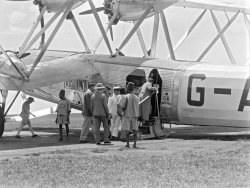
- Help on Wheels: 1917
- ... short skirts. This was the edict which went forth last night in the announcement of the establishment of a bureau of motor corps ... Posted by Dave - 07/24/2012 - 9:48pm -
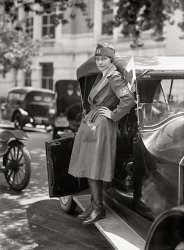
- Yank Tank: 1959
- ... bought it for $300, used to squeeze 9 in it on a Saturday night; great fun.
nostalgia My dad had one of these. Two tone pink of ... Posted by Angus J - 05/19/2012 - 6:46pm -
![Yank Tank: 1959 In 1958 my father worked for Ford and our family was transferred from Windsor, Ontario, to Geelong and Melbourne, Australia, for five years. Ford Australia cars were mostly British models, such as Zephyrs and Consuls. The Falcon was introduced and it took direct aim at General Motors Holden products. There were a few "Yank Tanks" around, and the 1959 Fairlane 500 would have been in that category. This Kodachrome was taken by my father on what appears to be a tour of Ford dealers, as Coates Motors was located in Bairnsdale, 280 km east of Melbourne. There is a rain deflector on the driver's side window -- Victoria state law still required hand signals. View full size.
The world's most beautifully proportioned car.According to The New York Times obit section of July 3, 1993, it was Fred Gwynne (Herman Munster and Francis Muldoon, among other roles) who came up with the slogan "the world's most beautifully proportioned car," for the 1959 Ford. He was working for the J. Walter Thompson advertising agency at the time, as a copywriter on the Ford account.
The model did win an award for exceptional styling from the Comite Francais de l'Elegance (whatever that was) at the Brussels World's Fair, presumably in 1959. Alex Tremulis of Tucker fame was at Ford during the period the '59 was designed, and offered a different take: it was a worse mistake than the '58.
Am wondering if the right hand drive was the only thing that distinguished the car from its American counterpart.
One probable difference in AustraliaThe rear turn indicators of some American cars of that period used to flash the red brake light. In Australia they added an amber flasher. I have seen in years gone by a number of truly awful added-on turn indicators on the underside of the tips of the gull wings of 1959 Chevrolets. Truly tragic.
Time Machine, pleeeease?Oh how I long to climb into a time machine and just go visit there, even for only one afternoon. The colors, the cars, those globe top gas pumps...
As for the difference between the US and Australian "tank Fairlane": In Australia, 1959 was a very long year.
In the United States there were entirely different bodies on 1960 and 1961 full sized Fords. In Australia that same body was made for all 3 years. There are 1960 and 1961 versions of that same car.
I know that the grille insert of the 1960 and 1961 versions has a different pattern than the four pointed stars of the 1959, but I can't tell if this grille insert is entirely the same as on the US car, from just this distant shot.
Fords Down Under/Up OverHere's what I've been able to glean from the net.
Not the EdselThe Ford Zephry as used in the seminal British police show 'Z Cars' 1962-1978 which incidentally has one of the best theme tunes in TV history.
http://www.youtube.com/watch?v=rWflrCrwUSw&feature=related
Taking a Grille-ing, 1959 Canadian MeteorMust be the lighting that makes the 1959 Australian grille inserts look like they could be pot metal castings, rather than stamped aluminum.
The US example is clearly stamped aluminum.
The 1959 Australian grille insert matches it in that it has four vertical rows and 21 stars across the first row. Probably the same.
But we have one more fine Ford family member now, that has to be examined.
The 1960 and 1961 grilles come from the Canadian Meteor. (Not a huge stretch to understand how that happened since the parts to assemble the Australian Fords were shipped from Canada, to Australia, not from the USA).
1955 Meteor = 1958 Australian FordTrivia: At first I thought that tri-toned white/pink/pink model to the right was a 1955 Meteor--the Canadian equivalent of Ford, which had its own grille and trim. Turns out that the 1958 Ford was "facelifted" with (presumably) leftover 1955 Meteor grilles.
Re: The world's most beautifully proportioned carI'm quite sure the gold medal award from the Comité Français de l'Elegance, indeed given at the Brussels World Fair, was aimed at the '58 model.
For one thing, the Brussels World Fair lasted from april 17 till october 19 in 1958. Typically, the new Fords were introduced in early to mid October (in the USA), and up to January elsewhere. I'm sure they would not have shown a car that no one was supposed to see, and before its true introduction date.
And furthermore, I have an old Belgian newspaper from 1958, with an ad from Ford showing a '58 model along with a caption boasting the gold medal award from the fair.
[A quick Google shows that the 1959 Fords were similarly honored. - Dave]
MemoriesThe car on the right, closest to camera GSF-777 is a 1957 Customline, the second one GYW-910 is a 1958 Customline. Most the Fords that made it out here were the Customline model and they proved very popular both as a daily drive and on the race track; a 56 model is still seen in the historic class. First car I owned was a 56 model, bought it for $300, used to squeeze 9 in it on a Saturday night; great fun.
nostalgiaMy dad had one of these. Two tone pink of all colors.
We drove across country in it in 1960, the longest driving vacation of my life.
He PAID to have the air conditioning removed.
All I can think is insanity.
59 FordI have a pale blue 59 Ford that I have been driving for many years
Mirrors?Rain deflector, but no outside mirror? The things we take for granted!
My grandad's 57 Chevy had maual turn signals - you had to turn them off by hand! Automatic turn signal canceling was an optional extra.
(ShorpyBlog, Member Gallery)](https://www.shorpy.com/files/images/img459.thumbnail.jpg)
- Caroline's Kitchen: 1939
- ...
Thanks for the great job you do at Shorpy (day & night), and your nice comments!
How is it possible that all your pictures ... Posted by Dave - 07/30/2012 - 2:42pm -
![Caroline's Kitchen: 1939 July 1939. Caroline Atwater standing in the kitchen door of her log house. Orange County, North Carolina. View full size. Medium-format nitrate negative by Dorothea Lange for the Farm Security Administration.
sleepDon't forget to go to bed every now and then!
Thanks for the great job you do at Shorpy (day & night), and your nice comments!
How is it possible that all your pictures have such a great resolution? If I Google around and come at several places about American history I will find (quite often) the same picture as you deliver us, but never at such a resolution.
Pure magic! Could you reveal the secret behind that?
[The original photographs don't lack for resolution. In fact the large-format cameras of 100 years ago generated higher resolution photographs than 35mm film and today's digital SLRs. The secret is taking the time to work with the high-resolution scans in Photoshop to pull out the details - Ken]
Caroline's KitchenThis photograph is just plain exquisite. Shorpy has an embarrassment of pictorial riches, but even in such estimable company, this is a standout.
I am veering far too close to obsequious gushing, so let me just say once again, "Great job, guys!"
Aunt CarolineI want to go inside and have a cuppa cawfee with Aunt Caroline. And listen to her reminisce about when she was a girl.
digitalI think you have to consider that Lange was almost invariably using a view camera. Most digital cameras are 35mm or less. Large format can be had for many thousands of dollars. Digital images are every bit as sharp as those of Lange's time - if you know how to develop them.
It almost makes me cryLooking at the detail in her dress, the wood - everything makes it so clear how much we are losing right now in this stage of digital photography. I look at the photos here daily and I sometimes feel sad that although digital has brought us an explosion of photographs - it lacks the richness of a photo like this.
Photo qualityThanks Ken, I read the whole story about your way to improve the quality at the "Jailhouse Rock: 1941" photograph
https://www.shorpy.com/jailhouse-rock#comments
great work from you guys (at least I found a name new to me: Ken, most of the time I see Dave!).
[I notice that Ken hes changed his name to "Lexybeast", is that correct? - Alex, March 27, 2020
(The Gallery, Dorothea Lange, Rural America)](https://www.shorpy.com/files/images/8b33913u1.thumbnail.jpg)
- Happy New Year!
- ... in front of the older man.
This was when the Sunday Night Movie ruled. No cable, no VCR.
Just watch the best program of the ... Posted by hillie_bolliday - 09/19/2011 - 11:21pm -
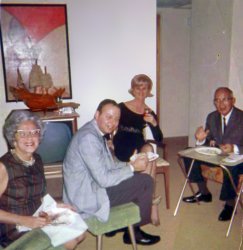
- Country Kitchen: 1938
- ... Probably for those last-minute hairdo touchups before a night on the town!
(The Gallery, Kitchens etc., Sheldon Dick) ... Posted by Dave - 10/16/2018 - 7:08pm -
![Country Kitchen: 1938 1938. "Tolland County, Connecticut. The kitchen on the Schneider farm." Acetate negative by Sheldon Dick for the Farm Security Administration. View full size.
Bzzzz"A fly on the wall is what I'd love to be", said one fly on the flypaper to another fly on the flypaper.
Familar curtainsWe had very similar curtains in the kitchen of my childhood in the 1950s, and the sink is identical.
The Bloom Is Off the RoseThe floral linoleum looks like a trampled garden.
I've come a long way, baby!I will only be 70 next July, but it amazes me what has transpired in my lifetime: From people in the country living with dirt floors and fairly recent electricity thanks to rural electric cooperatives, to this picture, which could have been my grandmother's kitchen as late as 1959, to stainless steel smart appliances and granite countertops.
I note with nostalgia the hole worn in the oilcloth tablecloth, probably from years of farm overalls rubbing against it as they rounded the tight corner on their way to the backdoor and the fields.
Noted also is the dropped ceiling -- very popular when trying to heat with a wood stove a drafty Victorian house, by closing off original 15-foot ceilings. I remember the hot water tank behind the stove from whence it gets heat.
[That's a coal stove. - Dave]
Flypaper - it still works!I once worked in the corner of a building, that for whatever reason, had a bumper crop of flies every fall. This was in the 1980s, at the HQ building of a major manufacturer of minicomputers.
I bought some flypaper, hung it from the suspended ceiling, cured one problem, and created another.
Management was less than pleased. By the time they complained, however, the problem flies were all stuck to the paper and the problem was solved until the next fall, when a whole new crop of management had appeared. My immediate superior understood the issue and told me so.
Help me! Help me!My eyes were immediately drawn to the fly strip generously populated with several of their buzziness friends lying in repose on the kitchen table.
The obviously worn corners of the tablecloth are no matter when etymologists come to dine like Robert's fly eating girlfriend in Everybody Loves Raymond.
[Etymologists dine on words. The entomologists get the flies. - Dave]
OxydolThere’s a wide range of oxy- products out there that I like very much. It’s the hydrogen peroxide that does the scrubbing chemically.
1930s kitchen staplesOxydol detergent and Fly paper strips.
Soapstone Laundry SinkI've been around since 1949 and have seen many of those double basin soapstone sinks used for many different purposes. I can't recall ever seeing those nice porcelain topped inserts anywhere else until today.
It's a really great addition. I can't believe it wasn't more popular.
GhostlinessI see the family ghost brought her own chair. Also note the clever metal covers for the laundry sink to get counter space.
SighYep, my dog does that to the tablecloth, too.
Of Pressing NeedLooks like the woman of the house is getting ready to do some ironing today. Those two "sad" irons warming up on the stove will be at the ready. The "Glenwood K" coal stove must have been a real workhorse in this house. Together with that gigantic steam radiator, the kitchen must've been warm as toast on a cold winter's day.
SpookyThe ghost curtains and chair are interesting. Did the photographer fail to advance the film correctly, so that a part of a frame was double-exposed? If the camera had been moved during exposure wouldn't all the items in the frame be blurred?
[This is a flash exposure on sheet film; there are no frames to advance as in roll film. The ghost image in this inadvertent double exposure is what the camera saw without the flash -- only the brightest parts of the room. - Dave]
They had hot water heatas evidenced by the good-sized radiator just behind the stove. I like the little bleeder key hanging above the radiator. I also like the hand-operated hair clippers on the shelf next to the door. Probably for those last-minute hairdo touchups before a night on the town!
(The Gallery, Kitchens etc., Sheldon Dick)](https://www.shorpy.com/files/images/SHORPY-8c02270a.thumbnail.jpg)
- Man of Steel: 1942
- ... Geneva, Utah. Servicing one of the floodlights that turn night into day on the construction site of a new steel plant needed for the war ... Posted by Dave - 07/30/2012 - 10:49am -
![Man of Steel: 1942 November 1942. Columbia Steel at Geneva, Utah. Servicing one of the floodlights that turn night into day on the construction site of a new steel plant needed for the war effort. View full size. 4x5 Kodachrome transparency by Andreas Feininger.
KodachromeThat's it, I'm buying some Kodachrome right now. I haven't shot 35mm in years (though I do continue to shoot 120 in a twin lens camera). Unfortunately, modern lens coatings give colors that can be immediately distinguished from those of earlier generations. I will have to pick out an older lens to have any hope of images like the one above.
Perhaps somebody smarter than I am can explain the focal plane in this image -- how can the man's face be in focus, and the bulb, but not his hand?
[The bulb is at the back of the reflector, a few inches closer to his face than his hand is. - Dave]
CS2/3 FiltersI would love to know where you get these filters from! I am a new-ish photographer, and I work with cheapie equipment. It seems this may be the trick to add that extra "oomph" to what can be a dull photo. (My all too common result of cheap lenses and cheap cameras!)
Thank you ^_^
Beffy
[The filters come with Photoshop. - Dave]
Kodachrome IIRe the comment below, the Kodachromes on the LOC website are raw tiffs right off the scanner, not corrected for color cast. They are all processed (by me) using the various filters in Photoshop CS3. Most of them have a greenish-yellow cast probably due to aging of the film, characteristics of the scanner (Sinar 54) or a combination of both. Below is a before-and-after example. Click the image to view full size.
Another example (underexposed, strong blue color cast):
Another great photograph.Another great photograph. You can see the photographer in the reflection of the bulb reflector! Neat!
Photoshop PluginI am looking for a photoshop plugin to achieve the amazing 40's Kodachromes we are seeing here at Shorpy.
[You don't need a plug-in. Just use the filters that are already there. - Dave]
Columbia SteelMy Dad was working for Columbia Steel at the time this photo was taken, in their Los Angeles mill. Columbia was later bought out by Alcoa.
Processing the photos>>>They are all processed (by me)
So is that a straightforward process, or is it lots of careful optimization that differs for each picture, to make them look so good?
[They're all different. There's a lot of futzing around. The older black-and-white glass negatives take the most time. - Dave]
I can't figureout what, exactly, he is doing to the fixture.
(The Gallery, Kodachromes, Andreas Feininger, WW2)](https://www.shorpy.com/files/images/1a34848u.thumbnail.jpg)
- Nipper's Love Nest: 1920
- ... National Photo usually shot its window displays at night to avoid the kind of glare seen here; close study will reveal a number of ... Posted by Dave - 05/08/2012 - 9:58pm -
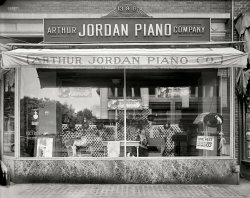
- Market Street: 1926
- ... rid of stale coffee too - not too many pedestrians late at night. Being there the last working day of the year was interesting. Office ... Posted by Dave - 11/09/2015 - 4:56pm -
![Market Street: 1926 San Francisco ca. 1926. "Market Street from Ferry Building." Note the backwards Owl Cigar signage. 8x10 nitrate negative, photographer unknown. View full size.
Foster and Kleiser billboardThe Maxwell House billboard bears the maker's name on top, Foster and Kleiser.
According to Wikipedia, that firm evolved into the current-day Clear Channel Outdoor Holdings, "the oldest outdoor advertising company in the United States as their roots trace back to the three companies that merged into the current incarnation: Foster & Kleiser (1901-1986), Patrick Media Outdoor (1986-1995) and Eller Media Company (1959-1997)."
Perfectly readable in the rearviewI bet that sign was designed for those people stuck waiting to turn into traffic off the side road. Anyone turning onto it would be past before seeing it, but if you're stuck waiting for traffic to clear and happen to glance in your mirrors it would be perfectly readable. How about an Owl?
[Generally speaking, 1920s cars did not have rearview mirrors, and the sign itself looks to be quite a bit older. Even in 1925, the majority of eyeballs passing by would have been on streetcars. While the sign might have reflected off the windows of the building across the street, I suspect eye-catching novelty was the strategy. - Dave]
19 Years EarlierThe same view taken while the City was still smoldering in 1906.
Spectral Christmas treeThere appears to be something swinging/spinning from the pole like a loose mast halyard in the right foreground, causing a Christmas tree-like artifact. Must have been a breezy day and a bright rope!
[The thing on the flagpole is the Stars and Stripes. There another one at the next street corner. - Dave]
Market Street: 1904And here it is pre-earthquake.
Hotel TerminalYou can check out any time you like but you can never leave.
Short cityNearly all of the low-rise buildings in that photo are gone now, wiped out between 1960-90. The Loma Prieta earthquake of 1989 was used as a feeble excuse for condemning the few remainders, including one in which I had been working just a couple years earlier. Fortunately, most of the vintage 10-12 storey buildings survive.
General OfficesThe building one block up on the left still stands. It was the headquarters of the Southern Pacific Railroad where I kept things running on Third Trick (midnights). My office was just past the balcony on the 6th floor facing Market Street. There was no need for air conditioning; you just opened the windows. We used the windows to get rid of stale coffee too - not too many pedestrians late at night. Being there the last working day of the year was interesting. Office workers had a strange habit of throwing small calendar pages (the kind that you flipped a page each day) out the windows before going home. It was almost like a ticker tape parade. A legion of street cleaners would have it all swept away by the next morning. Looking out the widows at the Hyatt Regency Hotel across the street might be interesting too - especially when a convention was in town.
Owl Cigars 5 cents M.A. Gunst & Co.Moses A. Gunst One of the most beloved men in the history of San Francisco.
http://www.jmaw.org/gunst-united-cigar-california/
One of My Faves From ShorpyThis is a great one! The guys painting the Maxwell House sign! Bernstein's Fish Grotto!
Why don't we name things "Grotto" anymore? Grottos had a good run but seemed to peter out by the 80's.
A truly historic photo This documents the last time there were parking spaces on Market Street in San Francisco.
Russ Building?Emporis says the Russ Building was finished 1927-- think that's it under construction, midway between 225 Bush and the Mark Hopkins?
[The building under construction is the Western Women's Club headquarters (a.k.a. "San Francisco Women's Club") at 609 Sutter. In the 1940s it became the Marines' Memorial Club and Hotel. - Dave]
(The Gallery, Cars, Trucks, Buses, San Francisco, Streetcars)](https://www.shorpy.com/files/images/SHORPY-755.thumbnail.jpg)
- The Ring: 1915
- ... and a sack and get as many as they could on a Saturday night.
By dawn on Sunday they'd have six or eight of them in the back of ... Posted by Dave - 07/12/2009 - 2:33am -
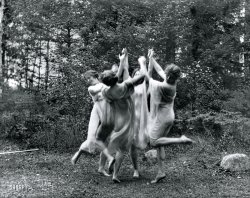
- Break Room: 1940
- ... store never closed. My wife and I stopped late on a winter night in '67. We were the only customers. Bought a Hudson Bay four point ... Posted by Dave - 11/04/2020 - 9:44am -
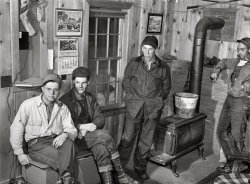
- French Opera House: 1900
- ... Toulouse Streets in 1859, it was destroyed by fire on the night of December 4, 1919.
Ow! If I were into editing pictures I think ... Posted by Dave - 08/14/2012 - 3:57pm -
![French Opera House: 1900 Circa February 1900. "French Opera House, New Orleans." 8x10 inch dry plate glass negative, Detroit Publishing Company. View full size.
Do NOT LikeDave:
The "Like" icon seems to have shown up most recently, possibly yesterday. I, for one, Do NOT Like the "Like" icon. This ain't Facebook, or Digg, or Twitter...my guess would be that people who appreciate and frequent this site couldn't care less about the mutual masturbations of the social media phenomenon.
[Your eloquent critique notwithstanding, Shorpy has 2,655 friends on Facebook (link below). Through their friends and friends of friends, thousands more people have been introduced to this site! - Dave]
http://www.facebook.com/shorpy
Awesome!There's not too many higher quality pictures of the Old Opera House. Many thanks for sharing!!
I bet the smell was ripe!With animals and open street drains. It must have been pretty bad, I understand how they couldn't dig underground sewers due to the high water table!
Re: Social NetworkingFacebook? Back in the 'old days' Shorpy was a hard-edged realist who didn't believe in Social Networking. As a non-facebooker, it's weird that one the first things on the Facebook page is the question, "Wrong Shorpy Higgenbotham? Search for others:" As if there were others.
[Ahem. "Higginbotham." - Dave]
Do LikeFacebook is how I found this fabulous website, and now I visit and enjoy daily. :) Shorpy is an amazing resource and an invaluable window into the past. I'm so glad I did find a way here. I'm constantly amazed with the luminosity of the images and the stories behind them.
And yes, I Facebook daily, too. Social media has its place, and if it helps to share history and spark an interest in and appreciation for what has gone before, then it at least serves another good purpose aside from remaining in contact with people easily. Having that button saved me time to cut and paste the link today - and I was glad to be able to share it easily!
Not long for this worldSadly, the French Opera House would stand for only another nineteen years. Built at the corner of Bourbon and Toulouse Streets in 1859, it was destroyed by fire on the night of December 4, 1919.
Ow!If I were into editing pictures I think I'd have to put sparks where it gives the illusion that the "This way to Levy's" finger touches the wire.
SalammboThe opera advertised, not the one of the same name in Citizen Kane, had its American premiere in this house in 1900.
Haunted by the Witch of the French OperaThe Witch of the French Opera lived in a house at Bourbon and Toulouse where the opera house once stood. Spurned by her young lover, the old Madam committed suicide, threatening in a final note: "I will Come back from the dead I will return, And kill those that have hurt me!" An many say return she did, to kill the man and his new love and to haunt tourists and locals for many decades to come.
I think the simplest thingwould be to ignore the Like button if it bothers you. It's there so people can show appreciation but not have to make a comment. It a very small thing. Chill. Enjoy Shorpy as always.
(The Gallery, DPC, New Orleans, Streetcars)](https://www.shorpy.com/files/images/4a04320a.thumbnail.jpg)
- Mouquin's: 1910
- ... agents, led by Arthur Van Tassel, at dinner hour last night raided Mouquin's restaurant, 454-8 Sixth Avenue, arrested Louis Mouquin ... Posted by Dave - 09/29/2015 - 11:49pm -
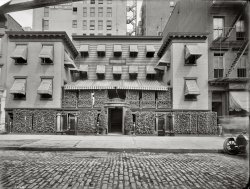
- The Oyster Wagon: 1905
- ... who arrived early yesterday morning went to bed last night with their cargoes still unsold. Many of the vessels were consigned ... Posted by Dave - 08/13/2012 - 7:27pm -
![The Oyster Wagon: 1905 Circa 1905. "Unloading oyster luggers at Baltimore." 8x10 inch dry plate glass negative, Detroit Publishing Company. View full size.
Bowlerstache"No man shall wear a bowler hat in public unless he is festooned with moustache." Baltimore Public Ordinance 23 of 1902.
Arlo Guthrie?The guy in the front of the picture looks like a young Arlo Guthrie. I've heard of Alice's Restaurant, but Alice's Oyster Bar?
[I think it's Richard E. Grant. - tterrace]
Those were the days,when oysters were the food of the masses.
Pirates of the Chesapeake???Back in those days, nighttime rustling of oysters out in the Bay from beds planted by commecial interests was a popular form of illegal enterprise. As a merchant sailor from Michigan, my mother's father, according to stories he told his children, was part of that trade. The oyster policew were hot on his trail by 1890, so he fled north to New York State and became an insurance man and real estate operator...somewhat of a less exciting job. This is a terrific photo.
Wilse
Keaton?I think the guy front center looks like Buster Keaton. He has the right hat anyway.
Also, front right is a telegraph boy. We have seen many pictures of child laborers with the photographer's seeming disapproval. What did telegraph boys grow up to do for work?
$1 per bushelWhoever captioned this photo for the Detroit Publishing Co. did not know their boats. While luggers were common in the Gulf Coast oyster fisheries, on the Chesapeake the dredgers sailed in bugeyes, pungies and skipjacks. The location of the photo is Pratt street; in the background is Pier 1 and the Maryland Lime and Cement Co.
Baltimore Sun, January 10, 1903.
Many Oysters Brought In
At Least 30,000 Bushels Arrive and More Coming.
Fifty sailing vessels deeply laden with oysters anchored in the harbor Thursday. It is estimated they contain at least 30,000 bushels of oysters, representing a value of $30,000 or more. Another large fleet is reported bound up from the lower bay, and some of the captains who have had experience in such matters said yesterday that a glut may ensue.
Yesterday along the wharves oysters were selling at prices ranging from 80 cents to $1.25 per bushel, according to size, quality and flavor. The demand was not unusually brisk, even for selects, and many captains who arrived early yesterday morning went to bed last night with their cargoes still unsold. Many of the vessels were consigned directly to the packing houses or are running under charter. Many other captains, however, depend solely on the market to dispose of their stock. Among some of these there was a feeling of uneasiness as the fleet continued to grow during the day.
At 4 o'clock yesterday afternoon there were 27 deeply laden oysters freighters in Canton Hollow or tied up along the Canton docks, discharging. At Pratt street, between Bowley's wharf and Light street, 23 loaded craft were tied up waiting to unload. Capt. Allen P. Vane, of the schooner Margaret H. Vane, which arrived Tuesday, said yesterday that he passed a large fleet of loaded oyster boats in the lower bay, bound for this port. They were expected to arrive this morning, as the southwest wind must have brought them hurrying up the bay yesterday afternoon.
The quantity of oysters now in port exceeds by far any previous day's record since the opening of the present season. Most of them are of fair quality from the York, Putuxent and Rappahannock rivers and from the Western Shore of the bay. Some are from Tangier and are very large. Very few are from the Eastern Shore of Maryland. The packing houses there are said to be using all the stock taken in those waters. Practically no oysters are coming from the upper bay and the present season there is said to be a failure. Local packing houses are running with full forces and have no difficulty in securing working stock. The $1.25 quotations yesterday were for select stock from the rocks which can be utilized as barrel stock. The prevailing prices hovered about $1.
Shucks!What you say when your oyster wagon tips over...
Skipjacks and Buy BoatsThe boats with the masts raked sharply back are skipjacks and bugeys. They would dredge for oysters. Early bugeyes were made from hollowed out logs, like big canoes. The more modern skipjacks appeared late in the 19th century.
Buy boats would go around and buy oysters directly from watermen at work on the bay and bring them into Baltimore and other ports to resell. The boats with the more vertical masts are likely buy boats, called luggers, I suppose, in different locales.
A sharply raked mast is an advantage when pulling a dredge, but otherwise makes for difficult sailing.
Here is a photo of a working skipjack or two that my father took at the Annapolis City Dock in October 1965. The Dock was full of working skipjacks at that time.
A banana and oyster sandwichIn the distance is the USS Constellation moored at Pier One Pratt Street today. This is also the same area where Bananas to Baltimore was featured a while back on these pages.
Dirty waterI always thought that the water would have been clean, but I daresay, it looked worse then!
Oyster warsThe last person killed over oysters was in the 1950's. There are two excellent books about oystering and the attendant violence. "The Oyster Wars" by David Faulkner and "The Oyster Wars of the Chesapeake Bay" by John Wennersten.
(If you're interested.)
http://www.amazon.com/Oyster-Wars-David-Faulkner/dp/1601455313
http://www.amazon.com/Oyster-Wars-Chesapeake-Bay/dp/061518250X
(The Gallery, Baltimore, Boats & Bridges, DPC)](https://www.shorpy.com/files/images/SHORPY_4a12585a.thumbnail.jpg)
- Square Dance: 1939
- ... pick cotton in the day and the grown ups dancing at night outside on a rough wood temporary dance floor lit with colored festoon ... Posted by Ken - 09/08/2011 - 6:35pm -
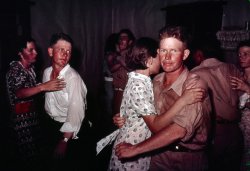
- Oysterboy: 1909
- ... says he starts out at 4 a.m. one day, is out all night in the little oyster boat and back next day some time. Gets a share of ... Posted by Dave - 08/03/2012 - 3:04pm -
![Oysterboy: 1909 January 1909. Apalachicola, Florida. "A young oyster fisher. Randsey Summerford says he starts out at 4 a.m. one day, is out all night in the little oyster boat and back next day some time. Gets a share of the proceeds. Said he was 16 years old and been at it four years. Lives in Georgia and is here six months a year." Glass negative and caption by Lewis Wickes Hine. View full size.
His Left FootI wonder what happened to his other shoe.
Oyster BoyJoe Manning, from the Lewis Hine Project. This young man died in 1971. I have requested his obit, and I have the address of one of his relatives. I'll let you know what happens.
Randsey Summerford...seems to be listed in the 1910 U.S. Census as Lounzo Summerford / Semmerfort, home Apalachicola, Franklin, Florida, occupation oysterman, age 18 born about 1892 in Georgia, father born in Louisiana but not listed, mother Margaret, 56, born in Georgia, one sister, Gena, same age and birthplace.
Photoshop footWhy doesn't his left foot cast a shadow like his right?
[It does. - Dave]
Smells FishyWhy is this kid the only white person in the frame? In this part of the country, (where I currently live) oystering was usually a family enterprise and it is very odd that a Negro crew would have a white employee (although, not vice-versa). I hope we find out more of backstory because I suspect, the census not withstanding, that Hines [sic] was either mislead [sic] or artfully arranged these people to fit his crusade against child labor.
[Hine's caption notation from a different oystering photo: "Mostly negro workers. The boss said, 'We keep only enough whites so we can control the negroes and keep them a-going!' " Below: Another mostly black Apalachicola oyster crew from January 1909. - Dave]
Oyster TongsOne thing I can tell you about oyster tonging is it takes a real man to do it all day. When I lived on the Chesapeake Bay in the 60's and 70's I had the opportunity to try my hand at using oyster tongs to harvest oysters....it ain't easy!!! The heavy tongs hinge about where his right hand is and when dropped straight down to the bottom the jaws open about one foot for a spread at the surface of about four feet. After closing the jaws to scrape oysters from the bed the rig is hauled back up and opened to release the oysters on deck. For pussies like you and I it is hard just to do it a few times much less all day. Oystermen have fantastic arm and chest muscles and one thing for sure, don't ever get in a brawl with them...they are as tough as they come. When I went out with friends who were from oystering families they had quite a good-natured laugh at my pathetic attempts to oyster, though I worked out and was fairly active....after a few trips to the bottom and back I was pooped. So think about that when you look at these guys in the picture who had arguably one of the toughest jobs ever. "Oyster Boy" indeed!
OysterboyThis is Joe Manning, of the Lewis Hine Project. You can see my story of this boy at this link:
http://morningsonmaplestreet.com/2015/01/18/ramsey-summerford/
Tough OystermenTo further Anonymous Tipster's point from 2008, the young men who worked the oyster boats in Apalachicola, Florida, were indeed tough. I lived in that wonderful town for about five years in the mid-1960s and Chapman High's football team was consistently much better than others in their class. Considering how small that school was, it was remarkable.
I always chalked that up to the work many of those young men did on oyster boats. Their upper-body strength was uncanny.
--Jim
(The Gallery, Boats & Bridges, Florida, Kids, Lewis Hine)](https://www.shorpy.com/files/images/05407u.thumbnail.jpg)
- Dreamland: 1905
- New York circa 1905. "Dreamland Park at night, Coney Island." Among the attractions on view: "Fall of Pompeii" and "The ...
It all looks so CLEAN! Wow, what a GREAT night shot!
Sweet Dreamy Dreamland This lovely version of "Meet Me ... Posted by Dave - 07/20/2012 - 7:16pm -
